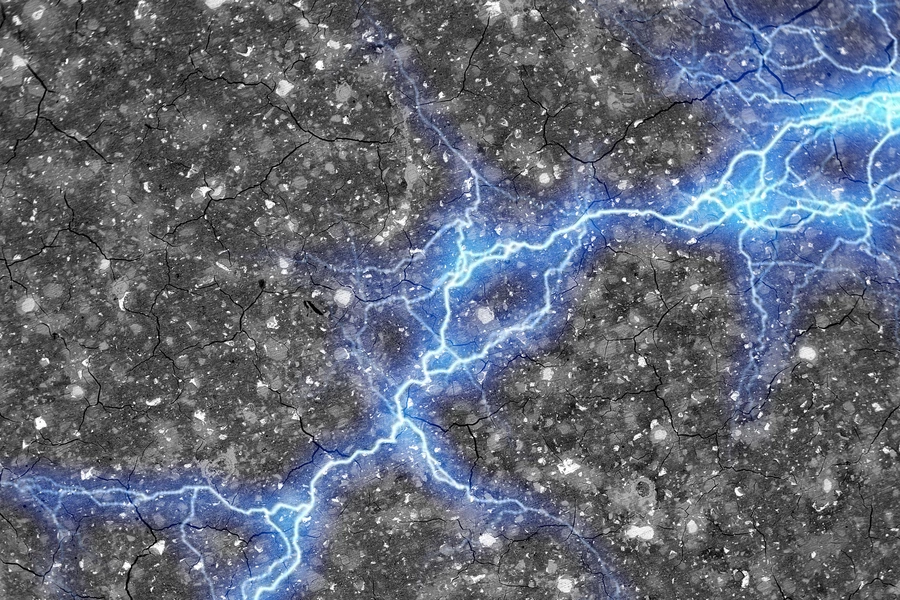MIT researchers have discovered that when you mix cement and carbon black with water, the resulting concrete self-assembles into an energy-storing supercapacitor that can put out enough juice to power a home or fast-charge electric cars.
We've written before about the idea of using concrete for energy storage – back in 2021, a team from the Chalmers University of Technology showed how useful amounts of electrical energy could be stored in concrete poured around carbon fiber mesh electrodes, with mixed-in carbon fibers to add conductivity.
MIT's discovery appears to take things to the next level, since it does away with the need to lay mesh electrodes into the concrete, and instead allows the carbon black to form its own connected electrode structures as part of the curing process.
This process takes advantage of the way that water and cement react together; the water forms a branching network of channels in the concrete as it starts to harden, and the carbon black naturally migrates into those channels. These channels exhibit a fractal-like structure, larger branches splitting off into smaller and smaller ones – and that creates carbon electrodes with an extremely large surface area, running throughout the concrete.
Two of these branches, separated by an insulating layer or a thin space, work happily as the plates of a supercapacitor once the whole thing's been bathed in a standard electrolyte, like potassium chloride.
Supercapacitors, of course, can charge up and discharge almost immediately, so power density and output is generally much higher than you'd get with a standard lithium battery.
Energy density is lower, and there's a tradeoff to be made between how much energy is stored volumetrically and how strong you need your concrete to be, since adding more carbon black both boosts energy storage and weakens the final concrete.
But the great thing here is that this energy storage device doesn't need to be small; concrete tends to get used in bulk. An average American 2,000-sq-ft (185.8-m2) home built on a reasonably standard five-inch-thick (13-cm) concrete slab uses about 31 cubic yards (~24 m3) of concrete. Add more if you've got a driveway or a concreted garage, and significantly more again if the house is built using concrete walls or columns.
The MIT team says a 1,589-cu-ft (45 m3) block of nanocarbon black-doped concrete will store around 10 kWh of electricity – enough to cover around a third of the power consumption of the average American home, or to reduce your grid energy bill close to zero in conjunction with a decent-sized solar rooftop array. What's more, it would add little to no cost.
The team has tested these concrete supercaps at small scale, cutting out pairs of electrodes to create tiny 1-volt supercapacitors about the size of button-cell batteries, and using three of them to light up a 3-volt LED. Now, it's working on blocks the size of car batteries, and targeting a 1,589-cu-ft, 10-kWh version for a larger-scale demonstration.

It's a super-scalable technology, according to MIT Professor Franz-Josef Ulm, co-author on a new study published yesterday in the journal PNAS.
“You can go from 1-millimeter-thick electrodes to 1-meter-thick electrodes, and by doing so basically you can scale the energy storage capacity from lighting an LED for a few seconds, to powering a whole house," says Ulm in a press release.
Looking beyond the home, concrete is absolutely everywhere, from buildings to ground coverings to the road network. The team says this energy-storing concrete could be paired with roadside solar panels and inductive charging coils to create super-quick, drive-through wireless EV charging roads thanks to the supercapacitors' ability to pump bulk juice on demand.
There's also presumably a lot of concrete used in the foundations of large grid-based energy storage facilities, which raises the interesting possibility that a giant concrete supercapacitor might pair well with a slower-moving chemical battery, giving it the ability to deliver jolts of power to the grid quickly as well as longer-duration contributions at lower power.
On the other hand, it's unclear whether this kind of concrete would be suitable for outdoor use where it'll get wet. It's also unclear whether these concrete supercapacitors can practically be poured on-site to self-assemble in situ. Or indeed whether each electrode pair needs to be sealed, or indeed exactly where and how you'd wire these blocks of concrete up to power your house, or indeed whether concrete supercapacitors like this would be safe to touch.
Certainly a fascinating project, though, and we'll be interested to learn how it progresses.
The research is open-access in the journal PNAS.
Source: MIT News





